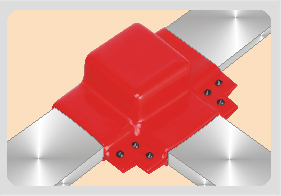
Busbar boots and busbar sleeve are two major busbar insulation shrouds used in the industrial electric environment. Workers are assured of safety while handling high voltage switchgear and work productively if these protective devices are installed. Busbar conductors are made of copper or aluminum and each of them have their distinct advantages though it is the latter that is increasingly used in today’s industrial environments.
Copper is chemically more stable than aluminum and its conductivity is also higher. Aluminum which is more active can be improved for its stability by addition of alloy elements in trace quantities. Copper has greater strength and hardness while the hardness and strength of aluminum alloy can be enhanced after heat treatment. Its strength exceeds that of copper because it is light weight. However, the use of copper is reducing mainly due to its higher cost. Copper resources are comparatively restricted and the rising cost in the smelting industry has led to a sharp increase in prices of copper. On the other hand, resources of aluminum are comparatively abundant and with the smelting technology being mature the prices of aluminum are lower. Aluminum bus bars are easier to be drilled through than copper bus bars and this facilitates putting the many connections on bus bars. A copper metal bar is several times heavier than aluminum bar. However, copper becomes a preferred choice when the load is higher or indirect current is high.
Whatever material is used for the bus bar, connections can fail if the surface is not cleaned and prepared properly and the required clamping force is not applied. Let us talk here on how to go about ensuring a clean surface. The first point in this context is, knowing whether the surface is clean or not. In case of copper bus bar if the surface appears to be clean then it would possibly be clean; though this is not the case in an aluminum bus bar connector. Aluminum oxidizes quickly. Because of the oxidation process, a thin film of aluminum oxide forms on the aluminum bus bar connector’s surface immediately upon cleaning it. This has to be cleaned through a surface treatment process if it has to work well for the required purpose.
One of the treatments that help in this context is plating. If there is an oxide film then cleaning the surface will require use of steel wool, wire brushes or fine sandpaper, but this has to be done with care. If in the process of cleaning there is some abrasion then that should not cause unevenness of the surface. The surrounding areas should also be safeguarded from loose particles and should be cleaned very well after abrading. Conductive particles may enter into insulating systems and cause havoc in future. At the same time it has to be ensured that particles of insulating material do not wind their way into conductive areas.
Your aim in preparation of the connector surface is to obtain a clean, flat surface which is one of the main factors that will enable you to obtain a good connection.